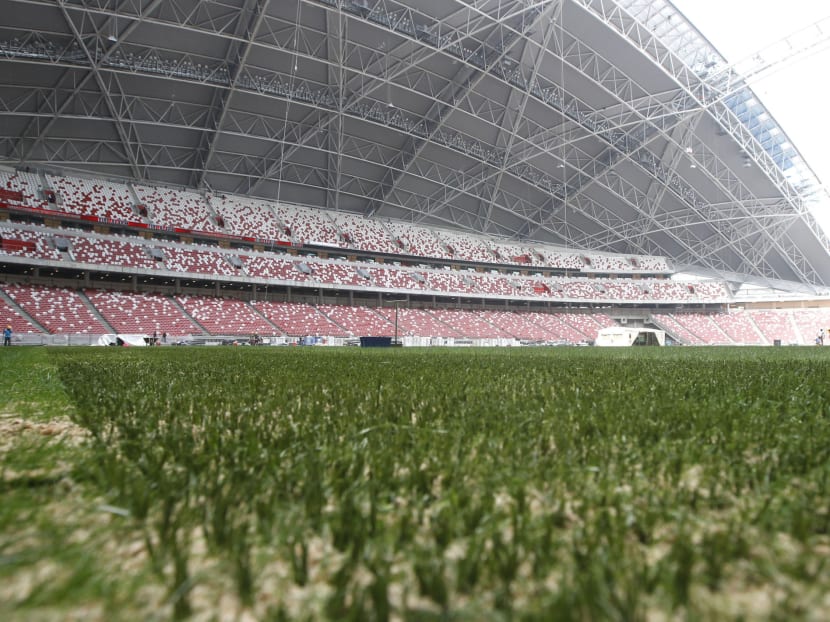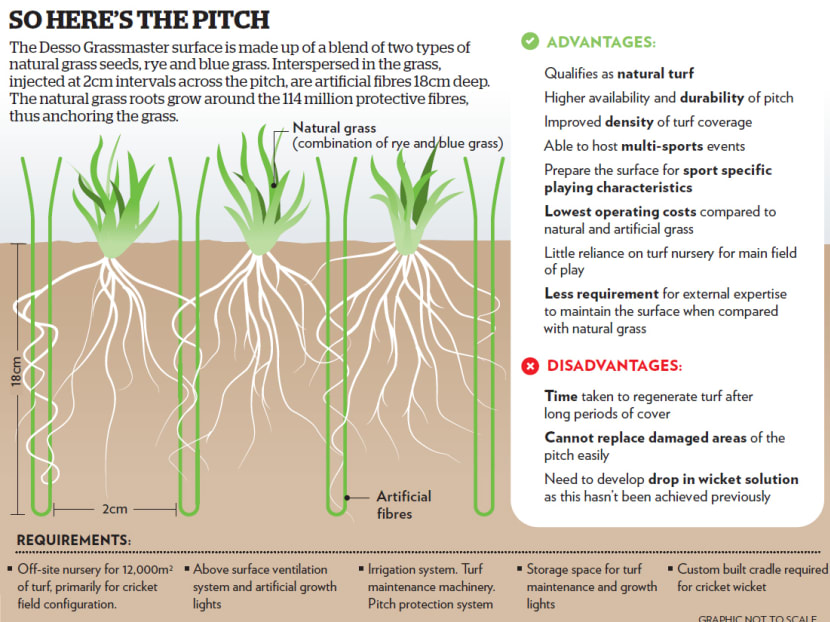National Stadium’s hybrid grass turf a first for Asia
SINGAPORE — The National Stadium, which is due to open next month, will boast a playing field that Sports Hub officials say is durable and cost-effective, and designed to minimise the risk of events being rescheduled or cancelled.


SINGAPORE — The National Stadium, which is due to open next month, will boast a playing field that Sports Hub officials say is durable and cost-effective, and designed to minimise the risk of events being rescheduled or cancelled.
The 55,000-seat centrepiece of the S$1.33 billion Sports Hub will be the first stadium in Asia to be turfed with the Desso GrassMaster, a reinforced grass that is estimated to cost about €500,000 (S$858,000) to install.
Specialised machines will inject a natural grass pitch with artificial fibres 18cm into the sand and at 2cm intervals — or about 114 million protective fibres in all.
This allows the grass — a blend of rye and blue grass selected from 20 types after 15 months of tests — to anchor its roots around the fibres for added strength.
The regeneration process starts after just three days, with full recovery after two weeks, compared with conventional natural grass, which requires about four weeks.
Coupled with the pitch’s drainage system, which works at 600ml per hour, it means the possibility of events being rescheduled or cancelled due to the poor surface is greatly minimised.
SportsHub’s senior director (stadia) Greg Gillin said the grass system will provide significant long-term savings for the sports complex, as the Desso GrassMaster’s maintenance costs are one-quarter that of lay-and-play natural grass surfaces.
“With this surface, we don’t change it. Even if we lose the grass, we can still play a game on it. You are (already) in front by about S$1.5 million to S$2 million per year just in operating costs,” he said.
“We’re talking about S$400,000 to S$500,000 to replace a lay-and-play surface. And with the event calendar we’ve got, a lay-and-play surface would probably last a month, maybe two. So that means about eight surfaces a year depending on the number and type of events, (and the costs) quickly start to mount.”
Desso, a Belgian firm specialising in fields for sports including football, hockey, rugby and tennis, says the GrassMaster has been approved by world governing sports bodies including football’s FIFA and athletics’ International Association of Athletics Federations (IAAF).
It has installed the surface in about 600 venues, including London’s Wembley and Emirates stadiums, as well as the Arena de Sao Paulo, where the World Cup opening match between hosts Brazil and Croatia will be held on June 12.
The system eliminates many disadvantages of other playing surfaces — natural turf is easily damaged and requires more maintenance, while artificial pitches have been criticised for being too hard and contributing to a higher rate of injuries — although a drawback is the difficulty of replacing damaged portions.
While small repairs can be done manually, Desso chief executive officer Alexander Collot d’Escury said arrangements are being made for repair machinery to be available. A local team will also be set up to maintain the pitch.
Among the first events at the National Stadium are the World Club 10s Rugby championship from June 21 to 22, the football matches involving Singapore and Malaysia on Aug 8, and Italian Serie A champions Juventus against a Singapore Selection side on Aug 16.
Corporate interest in the Sports Hub is also rising. Already, 62 of its executive suites, priced between S$72,000 and S$272,000 annually, have been snapped up, while in November last year, OCBC Bank secured a 15-year naming rights deal worth more than S$50 million — Singapore’s biggest sports sponsorship deal to date — for five of the Sports Hub’s properties.
With so much at stake, Mr Gillin stressed the quality of the pitch cannot be underestimated.
“We want to maximise the patron’s experience and it would be affected if athletes played at just 80 per cent (or less because of the pitch),” he said.
“We could do about 90 events a year, but we’re looking at around 110. We want to push the envelope ... (but) need a surface that meets the requirements of our packed calendar. If we cannot meet our business plan, then we might as well not do it.”





